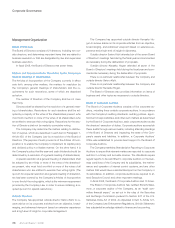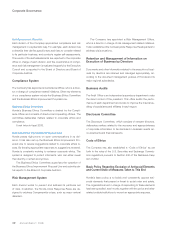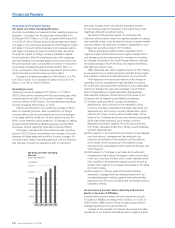Honda 2008 Annual Report Download - page 45
Download and view the complete annual report
Please find page 45 of the 2008 Honda annual report below. You can navigate through the pages in the report by either clicking on the pages listed below, or by using the keyword search tool below to find specific information within the annual report.
Companies listed on the New York Stock Exchange (NYSE) must
comply with certain standards regarding corporate governance
under Section 303A of the NYSE Listed Company Manual.
However, listed companies that are foreign private issuers,
such as Honda, are permitted to follow home-country practice in
lieu of certain provisions of Section 303A.
The following table shows the significant differences be-
tween the corporate governance practices followed by U.S. listed
companies under Section 303A of the NYSE Listed Company
Manual and those followed by Honda.
Corporate Governance Practices Followed by NYSE-
Listed U.S. Companies
Corporate Governance Practices Followed by Honda
An NYSE-listed U.S. company must have a majority of directors meeting
the independence requirements under Section 303A of the NYSE Listed
Company Manual.
For Japanese companies that employ a corporate governance system based
on a board of corporate auditors (the “corporate auditor system”), including
Honda, Japan’s Company Law has no independence requirement with
respect to directors. The task of overseeing management and, together with
the accounting audit firm, accounting is assigned to the corporate auditors,
who are separate from the company’s management and meet certain
independence requirements under Japan’s Company Law. In the case of
Japanese companies that employ the board of corporate auditors system,
including Honda, at least half of the corporate auditors must be “outside”
corporate auditors who must meet additional independence requirements
under Japan’s Company Law. An outside corporate auditor is defined as a
corporate auditor who has not served as a director, accounting councilor,
executive officer, manager, or any other employee of the company or any of
its subsidiaries. Currently, Honda has three outside corporate auditors which
constitute 60% of Honda’s corporate auditors.
An NYSE-listed U.S. company must have an audit committee composed
entirely of independent directors, and the audit committee must have at least
three members.
Like a majority of Japanese listed companies, Honda employs the board
of corporate auditors system as described above. Under this system, the
board of corporate auditors is a legally separate and independent body from
the board of directors. The main function of the board of corporate auditors
is similar to that of independent directors, including those who are members
of the audit committee, of a U.S. company: to monitor the performance of
the directors, and review and express an opinion on the method of auditing
by the company’s accounting audit firm and on such accounting audit firm’s
audit reports, for the protection of the company’s shareholders.
Japanese companies that employ the board of corporate auditors
system, including Honda, are required to have at least three corporate
auditors. Currently, Honda has five corporate auditors. Each corporate
auditor has a four-year term. In contrast, the term of each director of Honda
is one year.
With respect to the requirements of Rule 10A-3 under the U.S.
Securities Exchange Act of 1934 relating to listed company audit
committees, Honda relies on an exemption under that rule which is available
to foreign private issuers with boards of corporate auditors meeting certain
criteria.
An NYSE-listed U.S. company must have a nominating/corporate
governance committee composed entirely of independent directors.
Honda’s directors are elected at a meeting of shareholders. Its Board
of Directors does not have the power to fill vacancies thereon. Honda’s
corporate auditors are also elected at a meeting of shareholders. A proposal
by Honda’s Board of Directors to elect a corporate auditor must be approved
by a resolution of its Board of Corporate Auditors. The Board of Corporate
Auditors is empowered to request that Honda’s directors submit a proposal
for election of a corporate auditor to a meeting of shareholders. The
corporate auditors have the right to state their opinion concerning election of
a corporate auditor at the meeting of shareholders.
An NYSE-listed U.S. company must have a compensation committee
composed entirely of independent directors.
Maximum total amounts of compensation for Honda directors and corporate
auditors are proposed to, and voted on, by a meeting of shareholders.
Once the proposals for such maximum total amounts of compensation are
approved at the meeting of shareholders, each of the Board of Directors and
Board of Corporate Auditors determines the compensation amount for each
member within the respective maximum total amounts.
An NYSE-listed U.S. company must generally obtain shareholder approval
with respect to any equity compensation plan.
Currently, Honda does not adopt stock option compensation plans. When
Honda adopts it, it must obtain shareholder approval for stock options only
if the stock options are issued with specifically favorable conditions or price
concerning the issuance and exercise of the stock options.
Annual Report 2008 43
























